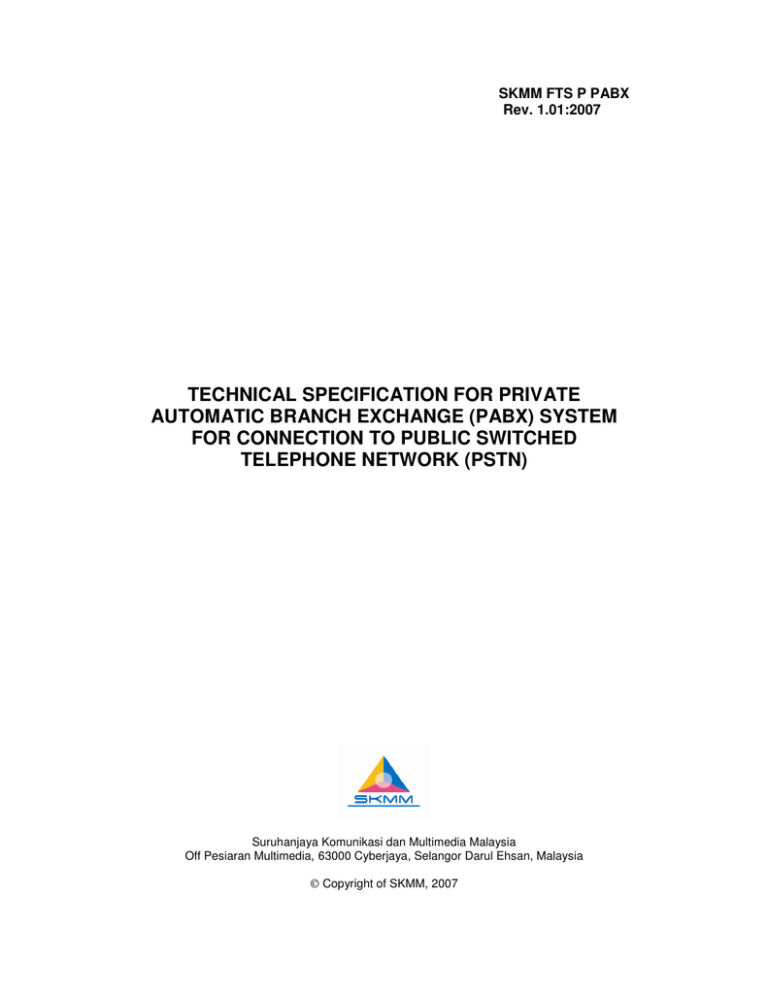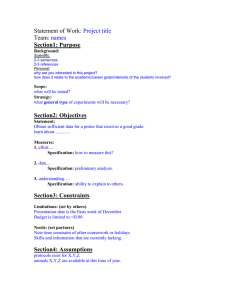technical specification for private automatic branch exchange (pabx)
advertisement

SKMM FTS P PABX Rev. 1.01:2007 TECHNICAL SPECIFICATION FOR PRIVATE AUTOMATIC BRANCH EXCHANGE (PABX) SYSTEM FOR CONNECTION TO PUBLIC SWITCHED TELEPHONE NETWORK (PSTN) Suruhanjaya Komunikasi dan Multimedia Malaysia Off Pesiaran Multimedia, 63000 Cyberjaya, Selangor Darul Ehsan, Malaysia Copyright of SKMM, 2007 SKMM FTS P PABX Rev. 1.01:2007 FOREWORD This Technical Specification was developed under the authority of the Malaysian Communications and Multimedia Commission (SKMM) under the Communications and Multimedia Act 1998 (CMA 98) and the relevant provisions on technical regulation of Part VII of the CMA 98. It is based on recognised International Standards documents This Technical Specification specifies the standards to conform for testing and certification on telecommunications equipments. NOTICE This Specification is subject to review and revision i SKMM FTS P PABX Rev. 1.01:2007 CONTENTS Page Foreword............................................................................................................... i 1 Scope..................................................................................................................... 1 2 Normative references ............................................................................................ 1 3 Abbreviations ......................................................................................................... 1 4 Requirements ........................................................................................................ 2 Table 1 Ringing Signal and Service Tone.................................................................... 5 Annex A Normative references..................................................................................... 7 ii SKMM FTS P PABX Rev. 1.01:2007 TECHNICAL SPECIFICATION FOR PRIVATE AUTOMATIC BRANCH EXCHANGE (PABX) SYSTEM FOR CONNECTION TO PUBLIC SWITCHED TELEPHONE NETWORK (PSTN) 1. Scope This technical specification describes requirement of Private Automatic Branch Exchange (PABX) system connected to Public Switched Telephone Network (PSTN). 2. Normative references The following normative references are indispensable for the application of this Technical Specification. For dated references, only the edition cited applies. For undated references, the latest edition of the normative references (including any amendments) applies. See Annex A. 3. Abbreviations For the purposes of this document, the symbols and abbreviations given in Table 1 apply. AC Alternating Current DC Direct Current EIRP Effective Isotropic Radiated Power ETSI European Telecommunications Standards Institute FCC Federal Communications Commission IEC International Electrotechnical Commission SKMM Malaysian Communications and Multimedia Commission TE Terminal equipment 1 SKMM FTS P PABX Rev. 1.01:2007 4. Requirements 4.1 General requirements 4.1.1 Power supply requirements TE may be AC or DC powered. For AC powered TE, the operating voltage shall be 240 V +5 %, -10 % and frequency 50 Hz ± 1 % as according to MS 406 or 230 V ± 10 % and frequency 50 Hz ± 1 % as according to MS IEC 60038 whichever is current. The design of the TE shall be such that all essential items of equipment of the TE shall be powered from batteries on float charge such that the performance of the system shall not deteriorate in any way on failure of the electricity mains supply. Non essential test equipment and other auxiliary devices may directly work off the electricity mains supply. The system shall operate on 48 volts (nominal) with positive earthen, and shall function satisfactorily within a voltage range of 42 volts to 54 volts for not less than 80% of the calls and shall function satisfactorily within a voltage range of 44 to 52 volts for 100% of the calls. Where external power supply is used, e.g. AC adaptor or battery, it shall not affect the capability of the TE to meet this specification. Adaptor shall be pre-approved by the relevant regulatory body before it can be used with the TE. 4.1.2 Power supply cord and mains plug requirements TE shall be fitted with a suitable and appropriate approved power supply cord and mains plug. Both are regulated products and shall be pre-approved by the relevant regulatory body before it can be used with the TE. The power supply cord shall be certified according to: - MS 140; or - BS 6500; or - IEC 60227-5; or - IEC 60245-4. The main plug shall be certified according to: - 13 A fused plugs: MS 589: Part 1 or BS 1363: Part 1; or - 2.5 A, 250 V, flat non-rewirable two-pole plugs: MS 1578 or BS EN 50075. 4.1.3 Polarity The performance of the TE shall be independent of the PSTN line polarity i.e. the TE shall conform to both polarities of the line feeding (ETSI TBR 21, clause 4.3.1). 2 SKMM FTS P PABX Rev. 1.01:2007 4.1.4 Interoperability and connectivity requirements TE shall comply with the minimum requirement that is specified by the regulatory body. 4.1.4.1 Interoperability TE shall be able to exchange information and to use the information that has been exchanged between two or more systems or components. 4.1.4.2 Connectivity TE shall be able to link with other programs and devices to allow interoperability. 4.1.5 Marking requirements TE shall be marked with the following information: a) supplier/manufacturer’s name or identification mark; b) supplier/manufacturer’s model or type reference; and c) other markings as required by the relevant standards. The markings shall be legible, indelible and readily visible. 4.1.6 Language All markings, software and related documents shall be in Bahasa Melayu or English language. 4.1.7 Electromagnetic Compatibility and electrical safety requirements 4.1.7.1 TE shall comply with the limits for conducted disturbance at the mains terminals and telecommunication ports, and the limits for radiated disturbance defined in the IEC CISPR 22. 4.1.7.2 TE shall comply with the MS IEC 60950-1 safety standard. The requirements in MS IEC 60950-1 that are applicable to the TE [e.g. class of equipment, type of telecommunication network voltage (TNV) circuit and types of components] shall be identified and complied with. 4.2 Technical requirements 4.2.1 Extension Telephones & Exchange Lines The PABX supplied shall be able to accept the use of : i) Dual tone multi-frequency (DTMF) push-button telephones. ii) Rotary dial telephones. iii) Mixture of i) and ii) above. PABX connected to PSTN shall be designed to meet the following requirements: 3 SKMM FTS P PABX Rev. 1.01:2007 a) Where PABX system is connected to PSTN, in addition to complying this technical specification, it shall comply with the requirements for connection to PSTN, SKMM FTS PSTN. b) Where PABX system supported A-CLIP, in addition to complying this technical specification, it shall comply with A-CLIP requirement, SKMM FTS P ACLIP. 4.2.2. Tones, Cadences 4.2.2.1 The frequency and cadence for the tones shall comply with the specification in Table 1. The allowable frequency deviation is ± 5% of nominal value. 4.2.2.2 The ring back tone shall be returned to the calling party whenever an extension line in the system is being rung, irrespective of whether the call is internal or external. 4.2.2.3 PABX with capacity above 100 extensions shall be incorporated with NU tone facilities and shall comply with Table 1. 4.2.3 4.2.3.1 Ringing Current Cadence of ringing current shall comply with the specification in Table 1. 4.2.3.2 Ringing current generator shall have open circuit voltage of not less than 75 Vrms and not greater than 85 Vrms and a design nominal frequency within the range of 16 Hz to 25 Hz. The total harmonic distortion shall not exceed 30 %. 4.2.3.3 Terminal voltage on full load shall be at least 60 Vrms. 4 SKMM FTS P PABX Rev. 1.01:2007 Table 1. Ringing Signal and Service Tone NO . 1 Ringing Current 2 Dial Tone 3 Ring tone 4 5 6 7 8 4.2.4 Internal call External call Ring Internal back call tone External call Busy Tone (Engage tone) Congestion tone Intrusion warning tone Number Unobtainable (NU) tone CADENCE (Second) 0.4 ON 0.2 OFF 0.4 ON 2.0 OFF FREQUENCY (Hz) 16-25 LEVEL (dBm) 75 Vrms 425 -15 to –9 425 -12 425 -15 to –9 425 - 12.0 425 -15 to –9 425 -15 to –9 425 -15 to –9 0.2 ON, 0.2 OFF 0.2 ON, 5.0 OFF 425 -15 to –9 2.5 ON, 0.5 OFF 425 -15 to –9 Continuous 1.0 ON, 3.0 to 5.0 OFF 0.4 ON, 0.2 OFF 0.4 ON, 2.0 OFF 0.4 ON, 0.2 OFF 0.4 ON, 2.0 OFF 0.4 ON, 0.2 OFF 0.4 ON, 2.0 OFF 0.5 ON, 0.5 OFF Either, i) 0.5 ON, 0.5 OFF OR ii) 0.25 ON, 0.25 OFF Numbering Scheme 4.2.4.1 2xxx 3xxx 4xxx 5xxx 6xxx 7xxx 8x 9 0 1xx TYPE OF TONE ) ) ) ) ) ) The numbering scheme shall be as follows: Extension Numbers Extension Number/Abbreviated Dialling Tie Lines * Access to Exchange Lines PABX Operator Services NOTE. * Tie lines is a leased/dedicated circuit linking two PABXs located in different premises. 5 SKMM FTS P PABX Rev. 1.01:2007 4.2.4.3 TE with up to 50 extension lines, two digits numbering is acceptable. 4.2.4.4 TE with more than 50 extension lines and up to 500 extension lines, three digits numbering shall be used. 4.2.4.5 TE with more than 500 extension lines, four digits and above shall be used, depending on the capacity of the system. 4.2.4.6 Access digit for the public exchange lines shall be ‘9’. 4.2.4.7 Access digit for the operator shall be ‘0’. 4.2.4.8 The first digit of tie-lines access code shall be ‘8’. 4.2.5 4.2.5.1 Transmission Requirements Extension Line Circuit The equipment shall function satisfactorily with an extension line loop resistance of up to 1 500 ohms with a leakage resistance of down to 20 000 ohms. 4.2.5.2 Attenuation Transmission attenuation for the following call at 1,000 Hz, measured at respective termination of the system shall be as follows: a) Extension to Extension less than 8 dB. b) Extension to Exchange line circuit less than 2.5 dB. c) Extension to tie line circuit less than 0.5 dB. d) Tie line to tie line circuit less than 0.5 dB. 4.2.6 Route Restrictions 4.2.6.1 The route restriction equipment shall be of the type that counts the total number of digits dialled as well as analyse the number of pulses of the first two or three digits so as to render the route restriction facility as fool-proof as possible. 4.2.6.2 Alternatively the digit analysis in the route restriction equipment shall commence analysis of the first digit dialled only after the route restriction equipment detects the public exchange dial tone. The route restriction equipment shall reactivate the digit analysis function whenever the public exchange dial tone is detected. 4.2.6.3 First two digit “00” and first three digit “101”, “103” and “108” are barred. 6 SKMM FTS P PABX Rev. 1.01:2007 Annex A (normative) Normative references BS 1363: Part 1 13 A plugs, socket-outlets, adaptors and connection units Part 1: Specification for rewirable and non-rewirable 13 A fused plugs BS 6500 Electric cables Flexible cords rated up to 300/500 V, for use with appliances and equipment intended for domestic, office and similar environments BS EN 50075 Specification for flat non-wirable two-pole plugs 2.5 A 250 V, with cord, for the connection of class II-equipment for household and similar purposes ETSI TBR 21 Terminal Equipment (TE); Attachment Requirements for pan-European approval for connection to the analogue Public Switched Telephone Networks (PSTNs) to TE (excluding TE supporting the voice telephony service) in which network addressing, if provided, is by means of Dual Tone Multi Frequency (DTMF) signalling IEC 60227-5 Polyvinyl chloride insulated cables of rated voltages up to and including 450/750 V - Part 5: Flexible cables (cords) IEC 60245-4 Rubber insulated cables - Rated voltages up to and including 450/750 V - Part 4: Cords and flexible cables IEC CISPR 22 Information Technology Equipment - Radio disturbance characteristics - Limits and methods of measurement ITU-T Recommendation E.161 Arrangement of digits, letters and symbols on telephones and other devices that can be used for gaining access to a telephone network MS 140 Specification for insulated flexible cords and cables MS 1578 Specification for flat non-rewirable two-pole plugs, 2.5 A, 250 V, with cord, for the connection of class II-Equipment for household and similar purposes 7 SKMM FTS P PABX Rev. 1.01:2007 MS 406 Specification for voltages and frequency for alternating current transmission and distribution systems MS 589: Part 1 Specification for 13 A plugs, socket outlets, adaptors and connection units Part 1: Specification for rewirable and nonrewirable 13 A fused plugs MS IEC 60038 IEC standard voltages MS IEC 60950-1 Information technology equipment - Safety - Part 1: General requirements SKMM FTS PSTN Technical specification for terminal equipment connecting to the Public Switched Telephone Network (PSTN) SKMM FTS P ACLIP Technical specification for Analogue calling line Identity presentation (A-CLIP) facility for connection to Public Switched Telephone Network (PSTN) 8



